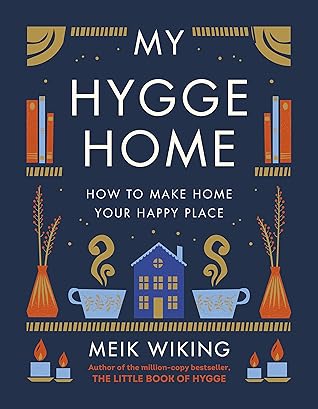More on this book
Community
Kindle Notes & Highlights
by
Meik Wiking
Read between
August 6 - August 21, 2025
hygge is about how we turn a house into a home—into a place where we find comfort and connection. Designing your hygge home is to imagine which activities can take place here that will have a positive impact on your well-being—and then shaping your living space to make that happen.
hygge is a situational sense of ease and pleasure—enjoying the here and now—an atmosphere brought about by the way you are with people, the mood of the encounter, and the feel of the physical space. The surroundings are very important when it comes to the feeling of hygge. It is about places with atmosphere.
Most people prefer natural to artificial light. We prefer having a window by our workspace. We prefer a view of trees over bricks. These preferences aren’t just aesthetic; they are directly linked to our mental health.
“Health is a state of complete physical, mental, and social well-being and not merely the absence of disease or infirmity.”
You are still as close to the neighbors as you are in the front yards; you can see them and they can see you, but interestingly, there is an unwritten rule that you don’t say hi to your neighbors when you see each other in the backyard. You don’t talk. I believe this is the difference between semi-public (front yard) and semi-private (backyard) space.
Hygge is about enjoying the process. About taking things slowly. And looking forward to the delicious results you will enjoy tucked up at home on a quiet wintry evening. It’s about enriching this time at home by knowing that you’ve got plenty of delights in store, ready for the perfect hygge moment. It’s about making your nights in special, and never feeling that you are missing out.
she says that to declutter your home you should place all similar items on the floor—say, your clothes or batter dispensers—then touch them one by one. If the item doesn’t “spark joy,” it should be thanked for its service, then donated or thrown out.
“The bitterness of poor quality remains long after the sweetness of low price is forgotten.”
The Diderot Effect means that when you buy a new thing, it can create a spiral of consumption that leads you to desire and acquire more new things your former self didn’t need in order to feel happy.
Get recognition from people because of the life you live, not because of the things you have. Remember, it is better to have stories to tell than stuff to show.
Controlling for all other factors, the researchers found that patients who could look at the green trees healed on average one day faster, had fewer post-surgical complications and needed significantly less pain medicine than their wall-facing counterparts.
The study found that the patients with the large photograph of the stream and trees were less anxious and needed fewer doses of strong pain medicine than those with the darker forest photograph, the abstract art, or the blank wall or white panel.
you can see a mile ahead what is coming, it is less interesting to walk around than it would be in the crooked streets you find in European town centers from medieval times. The curvy streets hold promises of a new discovery around every corner. The same goes for yards.
Living a hygge life and making a hygge home means understanding that happiness does not have to come with a price tag. It means learning how we can separate what we have from how we feel.
in the words of the great Ralph Waldo Emerson, “The ornament of a house is the friends who frequent it.”
In addition, a round table takes up less space than a rectangular one, as the curved edge optimizes the surface area. In order not to play “eating on the airplane,” with elbows bumping into each other, a rule of thumb is to give each person 24 inches of space so that they can sit comfortably (this does of course also depend on the chairs). A table with a diameter of 60 inches gives 186 inches of circumference, enough space for eight people. A table 48 inches in diameter seats five people.
consider how the chair and table settings facilitate connection This means applying the vacant chair principle, but it also means that when you have guests you help them make connections with each other, for example by mentioning some common ground or interest. For example, “You are probably the two people I know who know most about fermenting.” With a larger group of people, it’s helpful to think about the seating plan, and when you’re just eating with your family, it’s sometimes an idea to mix things up by switching away from the familiar seats at the dinner table to avoid things feeling
...more
One such game is the hygge game, which promises to create the right atmosphere for a hygge evening “with more than 300 thought-provoking questions. Cozy conversation in pleasant company. Perfect for a night in, a small party, or a dinner with friends or family.”
The hygge home is not an island; it is a place that knows it is part of a wider community, and it offers support and warmth to those in need.
It is said that the recipe for happiness includes something to do and something to look forward to. So pick a food project that will run for a couple of months.


